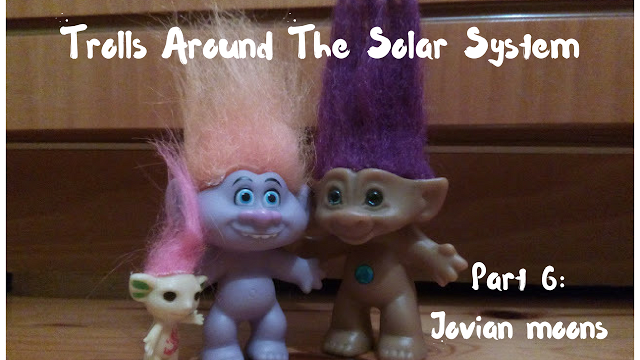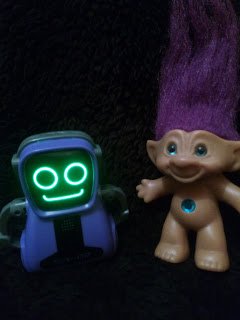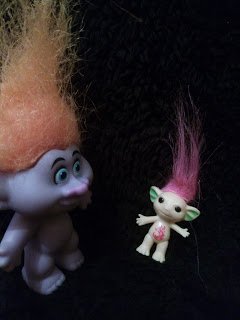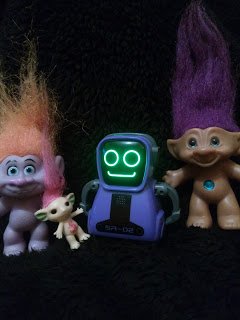Trolls Around The Solar System (Part 6 - Jovian Moons)

You can read here the previous parts: Part 1 (Mercury) - Part 2 (Venus) -Part 3 (Mars) - Part 4 (The Asteroid Belt) - Part 5 (Jupiter)
The trolls decided to take a tour among Jupiter's moon. The biggest planet of our solar system is thought to have 69 natural satellites, with four (Io, Europa, Ganymede and Callisto) being the bigger ones.

- So, how come and Jupiter got so many moons? X42 asked.
- It is believed that in the solar system's early stages, there was a spinning ring around young Jupiter, moons formed from it and then were attracted to the planet's mass, with new ones forming over and over again a couple of times, until there was no more material left, X31 explained.
- This as far as the satellites closer to the planet are concerned, the inner satellites, which are also called the Amalthea group and the main group or Gallilean satellites, the four biggest. The outer ones, or irregular satellites, are probably asteroids captured by Jupiter's gravity, T-800 added. They orbit in the opposite direction in which the planet spins. Weird, isn't it?
- Look! Ooooh! Aren't they beautiful? X54 pointed at a few spheres orbiting the planet.
- They are! X42 agreed.
- That one, looks like Swiss cheese! X54 laughed.
- It's Callisto, which is far enough not to be affected by Jupiter's strong magnetic field, X31 said. Callisto is heavily cratered and hasn't changed very much ever since it was formed.
- And that one over there? The huge moon? What's its name? X42 asked.
- That's Ganymede, T-800 answered, the biggest moon in the whole solar system. It is even bigger than Mercury.
- And it's the only satellite big enough to have its own, self-generated magnetic field, X31 added.
- With an iron core covered by ice, Ganymede is a real beauty, T-800 said.
- The other one that looks so bright is Europa, X31 continued. Europa is a life promising world. It is not cratered as much as the other Jovian satellites and because it is covered in ice, scientists believe the underlying oceans could be inhabitted.

- Er, I hope we don't get to meet any de-frosted alien, X54 was scared.
- I don't think so, X54. Relax, X31 tried to calm him down.
- And the last and closest to Jupiter is Io, T-800 said.
- Io is beautiful, look at all the colors! Red and yellow and orange, X42 said.
- And black and white, X54 added.
- Io is covered in sulfur and brown silicate, that's why it's so colorful, X31 explained. Below the silicate surface lies an iron or iron sulfide core.
- Io has also the highest volcanic activity in the whole solar system, T-800 said. It is so close to Jupiter, that as it orbits the planet, immense tidal forces act over its solid surface, triggering silicate magma blasts.
- That sounds scary! X54 said.
- Do you want to know a fun fact about three of the four moons? X31 asked.
- Yes please, the rest of the team answered.
- Io, Europa and Ganymede's orbits are kind of interlocked. For every orbit of Ganymede, Europa completes two and Io four. They also always show the same side to Jupiter, meaning that for every complete orbit around the planet they only turn once around their axis.
- Wow! Now that is perfect timing, X42 noticed.
- Speaking of timing, you know those moons were first observed by Galileo Gallilei in 1610, T-800 said, and one day after him Simon Marius saw them too.
- Although some Chinese guy claimed to be the first one to see them around 367 BC, X31 added.
- Right. But the names to the biggest four were given by Marius and weren't used until the 20th century, because until then people preferred numbers to names for celestial bodies, T-800 continued.

- All this is so fascinating! Too bad people don't come here often to see what we see, X54 said.
- That's why we are here, X54. To bring them images they will never see with their own eyes. With our descriptions and their imagination they will have a taste of what it looks like to take a tour of the solar system, X31 explained.
- Then quickly, let's go to the next planet! X54 said. People will be looking forward to see our next destination!
- And off we go, then! X31 said. Saturn here we come!
And the little DIY rocket continued its journey among the moons of Jupiter and headed towards Saturn. The famous rings were now waiting for the trolls to explore them.
To be continued...
References
space.com
solarsystem.nasa.gov
wikipedia.org
*Images by @ruth-girl
Thank you so much for your time!

Until my next post,
Steem on and keep smiling, people!

Awesome content! Couldn't stop grinning reading through it. :)
Thanks a lot!!! :D
Wait a minute... What did I just read? You teach real science through a sci-fi and surreal narrative? Womannnnnn, that's pure BRILLIANCE!!!!!!!!!!!!!!

Ahaaa! Those trolls are my mascot :P
Very nic
I loved it.
Thank you! :)
Neat way to teach others! Can't say I've ever read anything else quite like it
Thank you very much! :)
Aha! I never knew Jupiter has 69 moons. I guess we learn everyday.
P.S: When your trolls finishes from our solar system, would it move over to Andromeda? :)
Nice piece buddy
i don't know, they haven't seen all the planets yet :P
Thanks for reading @samminator!
I have interest about the science fiction. But your post has increased it in many times more.I have a friend who is a social worker. He is very interested and wants to work with you but he has no steemit ID. He has committed to me that if you help him to open a steemit ID. , he will transfer 20% of total earning from the steemit ID. to you. He waiting for you reply.
Καλημέρα..φοβερό όπος πάντα.. ο γιος μου θα σε λατρέψει αν του λες τέτοια παραμυθία.. 😀😀😀
Γεια σου Νικο!! Αμα ερθεις μεθαυριο να τον φερεις να του πουμε ιστοριες με τον θειο trumpman! :P
Αν έχει τελειώσει τις υποχρεώσει του θα τον φέρω.. αλλιώς σίγουρα στη επομένη συνάντηση 😀😀😀😀